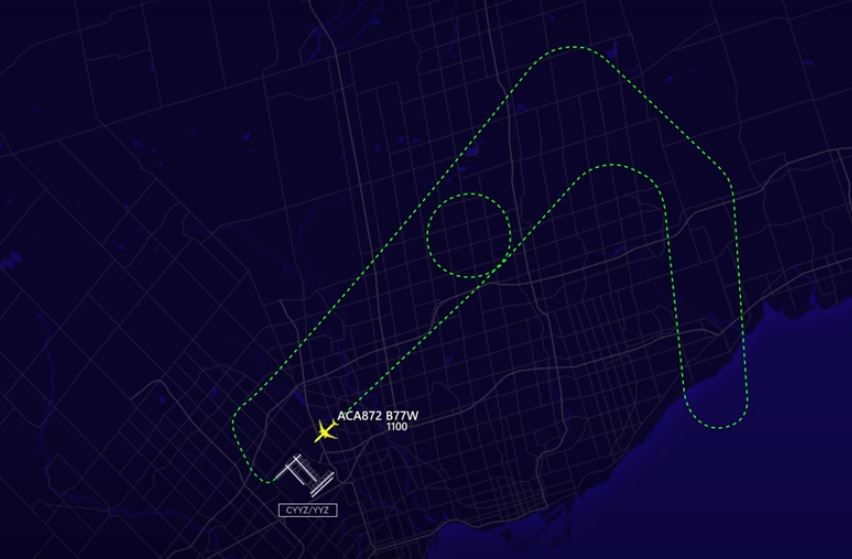
Air Canada Boeing Flight AC872 catches fire
Air Canada Boeing Flight AC872 catches fire
Table of Contents
- A Dramatic Takeoff: Air Canada Flight AC872 Encounters Trouble
- Flames and Quick Action: A Skillful Landing Averts Disaster
- Under the Hood: What Caused air Canada Boeing plane catches fire
- Staying Calm in the Skies: Passenger Safety During an In-Flight Emergency
- Learning from Experience: Improving Aviation Safety

A Dramatic Takeoff: Air Canada Flight AC872 Encounters Trouble
On June 5th, 2024, Air Canada flight AC872, a Boeing 777 wide-body aircraft, departed Toronto Pearson International Airport for Paris. The routine flight took a dramatic turn just minutes after takeoff. Passengers and onlookers witnessed a terrifying scene as flames erupted from one of the plane’s engines. Thankfully, the pilots displayed exceptional skill and composure, ensuring a safe return to Toronto

Flames and Quick Action: A Skillful Landing Averts Disaster
Videos captured by bystanders showed the harrowing ordeal. Flames flickered near the right engine as the plane ascended. Air traffic control, noticing the issue, promptly alerted the pilots. The crew declared a “PAN-PAN” distress signal, indicating a situation requiring assistance but not immediate danger.
With nerves of steel, the pilots prioritized the safety of everyone onboard. They made the critical decision to return to Toronto. The plane landed safely shortly after midnight, with emergency vehicles on standby as a precaution. There were no reports of injuries among the 389 passengers and 13 crew members. as air Canada boeing plane ac872 catches fire

Under the Hood: What Caused air Canada Boeing plane catches fire
The incident sparked an investigation into the cause of the fire. Initial reports suggest a malfunction within the engine known as a compressor stall. A compressor is a vital component that squeezes air into the engine, increasing its pressure and aiding combustion. A stall occurs when the airflow through the compressor disrupts, potentially causing components to overheat and ignite nearby materials.
While the exact cause is still under investigation, a compressor stall aligns with the observations of flames and the pilots’ reports. Air Canada is cooperating fully with investigators to determine the cause definitively and prevent similar incidents in the future.

Staying Calm in the Skies: Passenger Safety During an In-Flight Emergency
Airplane emergencies are rare, but it’s important to be prepared. The best course of action is to follow the instructions provided by the flight crew. Flight attendants are extensively trained to manage emergencies and ensure passenger safety.
Here are some key things to remember:
- Pay attention to the pre-flight safety briefing. This briefing outlines the location of emergency exits, life vests, and oxygen masks.
- Familiarize yourself with your surroundings. Locate the nearest exit and aisle during boarding.
- Stay calm and follow instructions. Crew members will provide clear and concise instructions during an emergency.
- Assist those who may need help. Children, elderly passengers, or those with disabilities may require assistance during an evacuation.
- Maintain a low profile and cover your mouth and nose with a cloth if smoke is present.
Learning from Experience: Improving Aviation Safety
The Air Canada incident serves as a reminder of the importance of aviation safety. Every incident, regardless of severity, provides valuable data for improving aircraft design, maintenance procedures, and crew training. Investigators will meticulously analyze the data from flight AC872 to identify any potential weaknesses and implement preventative measures.
Passengers can also play a part in aviation safety by being prepared and following crew instructions during emergencies. By working together, airlines, regulatory bodies, and passengers can ensure the continued safety of air travel.
While airplane emergencies are frightening, the quick actions of the pilots and the preparedness of the crew ensured a safe outcome for everyone onboard Air Canada flight AC872. By understanding potential causes of in-flight emergencies and following safety procedures, passengers can contribute to a safer flying experience for all.





Thanks for the detailed post about the dramatic takeoff of Air Canada Flight AC872. The account of the crew’s swift and professional handling of the situation was particularly reassuring.
One additional thought: incidents like this underscore the importance of continuous training and advanced technology in aviation safety. Ensuring that both pilots and flight attendants are well-prepared for emergencies can make all the difference.
For those looking to enhance their home environments, check out some stylish decor options at Phooldaan Decor.
Thank goodness for amazing pilots like these. I’m sure they do awesome things that we never hear about, as well.
“Wow, what a riveting account of Air Canada Flight AC872’s dramatic takeoff! Your detailed narration captured the tension and adrenaline of the moment perfectly. It’s incredible how the pilots’ swift actions and the crew’s professionalism ensured everyone’s safety amidst the unexpected challenges. Stories like these remind us of the skill and dedication of airline professionals, who handle such situations with grace and expertise. Looking forward to more insightful aviation stories from your blog!”
Your detailed account of Air Canada Flight AC872’s challenges captures the intensity and professionalism of the crew under pressure. A compelling read that highlights the importance of safety and expertise in aviation.
Temp mail Hi there to all, for the reason that I am genuinely keen of reading this website’s post to be updated on a regular basis. It carries pleasant stuff.